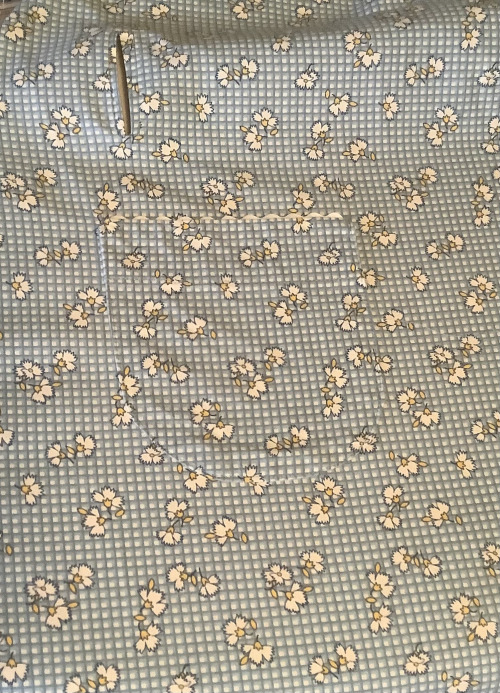In Praise of Small Prints: Or the Bungalow ApronI have blogged this dress before, but as I ironed it
In Praise of Small Prints: Or the Bungalow ApronI have blogged this dress before, but as I ironed it, I was thinking how much I admire the small prints on fabric of the past. The Dress Doctors always recommended them because they were easier to work with while dressmaking and they were not overwhelming to the average woman’s figure. This fabric was sold as a 1930s era reproduction. See here how easy it was for me to match the print where the patch pocket was placed. There was almost no waste in cutting out the pocket either. Matching was otherwise a moot point where the ruffles at the neck and the tiers or flounce below and as a wrap, it made little sense to try to match along the opening edge. Now if the flowers had been large, I would have had to think about where to place them so as to avoid the grotesque effect of two flowers over the breast or one landing at the crotch. And placing the pocket would have meant wasting fabric. I often am charmed with a print sold online, only to look at the photo with a ruler, realize the flowers are 3, 5 or even 7 inches across, and reject it. I cannot decide if the textile designers like to work with larger prints, if large prints sell well because they look better on a small screen for web buyers, of if making smaller prints is more difficult in the manufacturing process. I do know that I will hold out for them. You can find this pattern as a reproduction. It is a Hoover apron or bungalow dress, made famous during WWI when Herbert Hoover ran the government program on food conservation and the home economists designed an apron that wrapped and could be rewrapped when one surface became filthy. I know, kind of disgusting, but that was how it was made famous. Regardless of rewrapping, this makes for a nice summer robe, or even a casual daytime dress. Although wrapped dresses are not the most practical for wearing out of the house–fear the windy day–the length and amount of overlap makes it relatively secure. Find it here: https://www.etsy.com/listing/220673334/1930s-ladies-hooverette-day-dress?ga_search_query=1889&ref=shop_items_search_2&sca=1For many charming reproduction fabrics from the 19th and the 20th centuries, go here: http://www.reproductionfabrics.com/ -- source link
Tumblr Blog : professorpski.tumblr.com
#1930s fashions#bungalow dress#hoover apron#hooverette#vintage sewing#vintage dressmaking#sewing#dressmaking#diy projects#makers#making#costume history#dress history#textile history#textile prints#fabric prints#fabric design#reproduction fabrics#vintage fabrics

